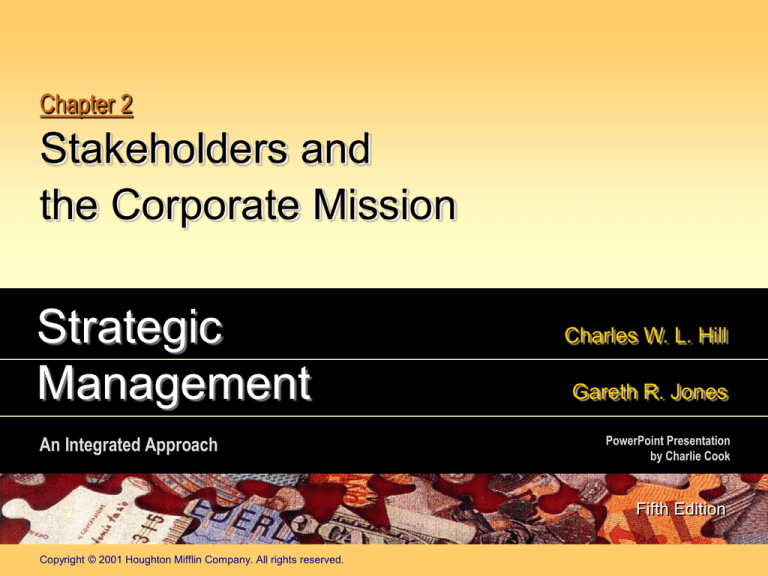
Chapter 2
Stakeholders and
the Corporate Mission
Strategic
Management
An Integrated Approach
Charles W. L. Hill
Gareth R. Jones
PowerPoint Presentation
by Charlie Cook
Fifth Edition
Copyright © 2001 Houghton Mifflin Company. All rights reserved.
Stakeholders and the Enterprise
Contributions
Inducements
Contributions
Inducements
FIGURE 2.1
Copyright © 2001 Houghton Mifflin Company. All rights reserved.
2-2
Stakeholder Impact Analysis
1. Identify stakeholders
2. Identify stakeholders’ interests and
concerns
3. Identify resulting claims stakeholders are
likely to make
4. Identify most important stakeholders (from
the organization's perspective)
5. Identify the resulting strategic challenges
Copyright © 2001 Houghton Mifflin Company. All rights reserved.
2-3
Mission Statement
A formal commitment to stakeholders that the
firm’s strategy incorporates and recognizes
their claims on the organization.
Mission statement elements:
A declaration of the overall vision, or mission.
A summation of managerial philosophical values.
An articulation of key organizational goals.
Copyright © 2001 Houghton Mifflin Company. All rights reserved.
2-4
Vision, or Mission
A statement of purpose (strategic intent)
committing the organization to ambitious
overarching (stretch) goals.
Provides a sense of direction and purpose.
Drives strategic decision making
and resource allocations.
Forces the seeking of
significant performance
improvements to
attain goals.
Copyright © 2001 Houghton Mifflin Company. All rights reserved.
2-5
Customer Orientation and Business Definition
Abell’s Framework
for Defining the
Business
Consumer-oriented
versus
Product-oriented
business definition
FIGURE 2.2
Copyright © 2001 Houghton Mifflin Company. All rights reserved.
Source: Derek F. Abell, Defining the Business: The Starting Point of
Strategic Planning (Englewood Cliffs, N.J.: Prentice-Hall, 1980), p. 17.
2-6
Values
Johnson & Johnson’s credo
sets its responsibilities to:
1. J&J product users.
2. J&J employees.
3. Communities in which J&J
employees live and work.
4. J&J stockholders.
FIGURE 2.3
Copyright © 2001 Houghton Mifflin Company. All rights reserved.
Source: Courtesy of Johnson & Johnson.
2-7
Goals
Good goal characteristics:
Precise and measurable
Address important issues
Challenging but realistic
Time period specified
The overriding organizational goal:
Maximizing shareholder returns.
Firms need both short- and long-term goals.
Copyright © 2001 Houghton Mifflin Company. All rights reserved.
2-8
The Corporate Governance Problem
On-the-job consumption
Elaborate and expensive
perks for top management.
Excessive pay not linked
to performance
Down markets and upward spirals of executive pay.
Empire building
Buying additional businesses that increase the size of
the company without increasing shareholder wealth.
Copyright © 2001 Houghton Mifflin Company. All rights reserved.
2-9
The Tradeoff Between Profitability
and Growth Rate
FIGURE 2.4
Copyright © 2001 Houghton Mifflin Company. All rights reserved.
2-10
Corporate Governance Mechanisms
Board of directors
Stock-based compensation
Corporate takeovers
Takeover constraints
Corporate raiders
Greenmail
Leveraged buyouts
Managers offer to exchange equity for debt in a
leveraged buyout (purchase of the company).
Copyright © 2001 Houghton Mifflin Company. All rights reserved.
2-11
Strategy and Ethics
The purpose of business ethics
To provide the tools for dealing with moral complexity
in strategic decisions.
Shaping the organization’s ethical climate
Emphasizing the importance
of strong ethical values by top
management.
Including the values in the
organization’s mission statement.
Copyright © 2001 Houghton Mifflin Company. All rights reserved.
2-12
Thinking Through Ethical Problems
A model of ethical decision making
FIGURE 2.5
Copyright © 2001 Houghton Mifflin Company. All rights reserved.
2-13
Corporate Social Responsibility
The sense of obligation to include social
criteria in strategic decision making.
Pro:
It is the right way for a firm to behave.
Economic actions have social consequences.
Social behavior affects the firm’s market value.
Con:
A firm’s primary obligation is to maximize profits for
its stakeholders in open competition.
Copyright © 2001 Houghton Mifflin Company. All rights reserved.
2-14

